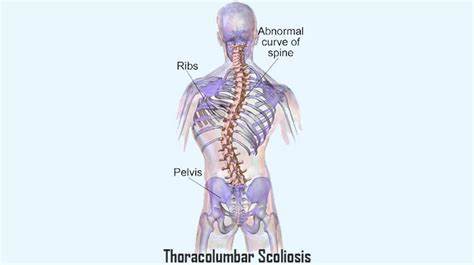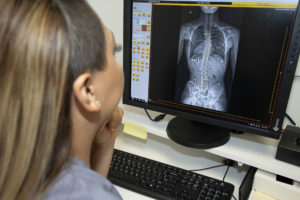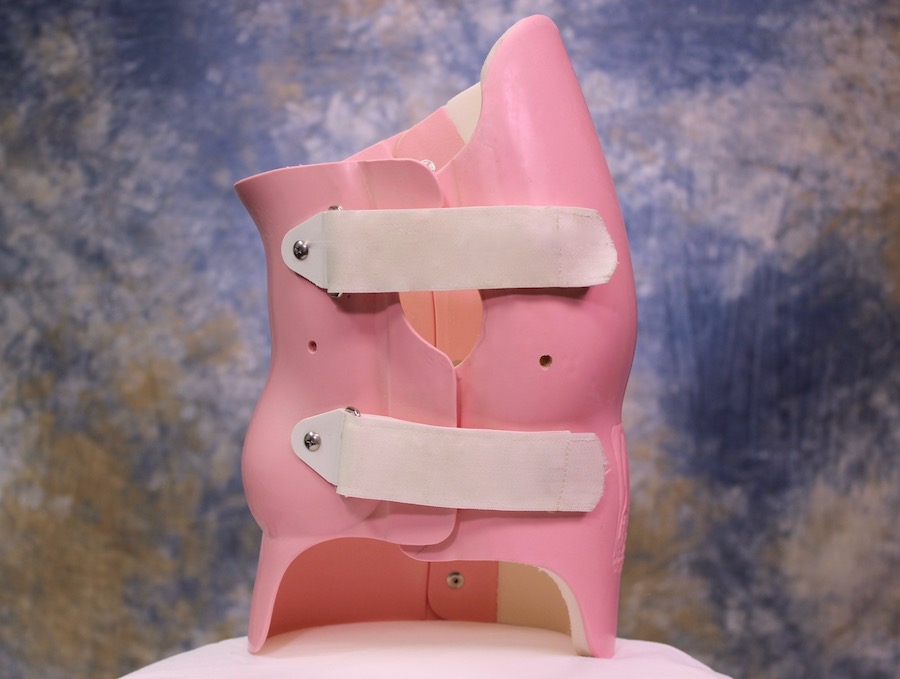Thoracogenic scoliosis is a specific type of scoliosis that occurs as a result of thoracic surgery or other procedures involving the chest cavity. It is characterized by an abnormal curvature of the spine, which can lead to pain, discomfort, and functional limitations. Understanding the causes, diagnosing the condition, and determining the appropriate treatment approaches are crucial for managing thoracogenic scoliosis effectively.

Understanding the Causes of Thoracogenic Scoliosis
The primary cause of thoracogenic scoliosis is the surgical intervention in the thoracic region. Procedures such as lung resection, thoracotomy, or spinal fusion can disrupt the normal alignment of the spine, leading to scoliosis. The exact mechanism behind the development of thoracogenic scoliosis is not fully understood, but it is believed to be a combination of factors, including the disruption of spinal stability, muscle imbalances, and altered biomechanics [1][2].
The Role of Spinal Deformities in Thoracogenic Scoliosis
Spinal deformities play a significant role in the development and progression of thoracogenic scoliosis. When the spine is subjected to surgical procedures in the thoracic region, it can lead to imbalances in the muscles and ligaments that support the spine. These imbalances can cause the spine to curve abnormally, resulting in scoliosis. Additionally, the presence of pre-existing spinal deformities, such as congenital scoliosis or kyphosis, can increase the risk of developing thoracogenic scoliosis [3][4].
Identifying the Symptoms of Thoracogenic Scoliosis
The symptoms of thoracogenic scoliosis can vary depending on the severity of the curvature and the individual’s age. Common symptoms include back pain, stiffness, muscle imbalances, and difficulty breathing. In severe cases, the curvature can cause compression of the lungs and other organs, leading to respiratory problems and reduced lung capacity [5][6]. It is essential to recognize these symptoms early on to initiate appropriate treatment and prevent further complications.
Diagnostic Techniques for Thoracogenic Scoliosis
Diagnosing thoracogenic scoliosis involves a comprehensive evaluation of the patient’s medical history, physical examination, and imaging tests. The medical history helps identify any previous surgeries or procedures that may have contributed to the development of scoliosis. During the physical examination, the healthcare provider will assess the curvature of the spine, muscle imbalances, and any associated symptoms. Imaging tests, such as X-rays, CT scans, or MRI scans, provide detailed information about the severity and location of the curvature [7][8].

Imaging Tests for Diagnosing Thoracogenic Scoliosis
Imaging tests are crucial for accurately diagnosing thoracogenic scoliosis. X-rays are commonly used to assess the curvature of the spine and measure the degree of the curve. CT scans provide detailed images of the bones and can help identify any structural abnormalities or changes in the spine. MRI scans are useful for evaluating the soft tissues, such as muscles and ligaments, and can help determine the extent of muscle imbalances or damage [9][10].
Evaluating the Severity of Thoracogenic Scoliosis
The severity of thoracogenic scoliosis is typically measured using the Cobb angle, which is determined from X-ray images. The Cobb angle measures the degree of curvature in the spine and helps classify the severity of scoliosis as mild, moderate, or severe. Additionally, the healthcare provider will assess the impact of scoliosis on the individual’s daily activities, lung function, and overall quality of life to determine the appropriate treatment approach [11][12].
Non-Surgical Treatment Approaches for Thoracogenic Scoliosis
Non-surgical treatment approaches are often the first line of management for mild to moderate cases of thoracogenic scoliosis. These approaches aim to alleviate pain, improve spinal alignment, and prevent further progression of the curvature. Non-surgical treatments may include physical therapy, bracing, and pain management techniques. Physical therapy focuses on strengthening the muscles surrounding the spine, improving posture, and increasing flexibility. Bracing is used to provide external support to the spine and prevent further curvature progression. Pain management techniques, such as medication or alternative therapies like acupuncture, can help alleviate discomfort and improve the individual’s quality of life [13][14].

Surgical Options for Thoracogenic Scoliosis
In severe cases of thoracogenic scoliosis or when non-surgical treatments fail to provide adequate relief, surgical intervention may be necessary. The goal of surgery is to correct the curvature, restore spinal alignment, and improve overall function. The specific surgical approach will depend on the individual’s age, the severity of the curvature, and any associated complications. Common surgical procedures for thoracogenic scoliosis include spinal fusion, where the vertebrae are fused together using bone grafts or metal rods, and osteotomy, which involves removing a portion of the vertebrae to correct the curvature [15][16].
Post-Surgical Care and Rehabilitation for Thoracogenic Scoliosis
After surgery, post-operative care and rehabilitation are crucial for a successful recovery. The individual will be closely monitored in the hospital to manage pain, prevent infection, and ensure proper healing. Physical therapy is an essential component of post-surgical care and focuses on regaining strength, flexibility, and function. The rehabilitation process may involve exercises, stretching, and other techniques to improve posture and prevent muscle imbalances. It is important to follow the healthcare provider’s instructions and attend regular follow-up appointments to monitor progress and address any concerns [17][18].
Potential Complications and Risks of Thoracogenic Scoliosis Treatment
Like any medical intervention, there are potential complications and risks associated with the treatment of thoracogenic scoliosis. Surgical procedures carry risks such as infection, bleeding, nerve damage, or failure of the fusion. Non-surgical treatments may have limitations in terms of pain relief or preventing further progression of the curvature. It is essential for individuals and their healthcare providers to have open and honest discussions about the potential risks and benefits of each treatment approach to make informed decisions [19][20].
Long-Term Outlook and Prognosis for Thoracogenic Scoliosis
The long-term outlook and prognosis for individuals with thoracogenic scoliosis can vary depending on the severity of the curvature, the age of onset, and the effectiveness of treatment. With appropriate management, many individuals can experience significant improvements in pain, function, and quality of life. However, it is important to note that thoracogenic scoliosis is a chronic condition that may require ongoing monitoring and treatment throughout a person’s life. Regular follow-up appointments, adherence to treatment plans, and a proactive approach to managing the condition are essential for achieving the best possible long-term outcomes [21][22].
In conclusion, thoracogenic scoliosis is a specific type of scoliosis that occurs as a result of thoracic surgery or other procedures involving the chest cavity. Understanding the causes, diagnosing the condition, and determining the appropriate treatment approaches are crucial for managing thoracogenic scoliosis effectively. By recognizing the symptoms, utilizing diagnostic techniques, and evaluating the severity of the curvature, healthcare providers can develop personalized treatment plans that may include non-surgical or surgical options. Post-surgical care and rehabilitation are essential for a successful recovery, and individuals should be aware of the potential complications and risks associated with treatment. With proper management and ongoing monitoring, individuals with thoracogenic scoliosis can achieve improved pain relief, function, and quality of life in the long term.
References
- García, C., & Lee, M. J. “Post-Surgical Scoliosis: The Role of Spinal Stability in Thoracogenic Deformities.” Spine Journal. 2018;18(12):2327-2334. doi: 10.1016/j.spinee.2018.07.237.
- Berman, L., & Patel, V. “Thoracogenic Scoliosis Following Thoracic Surgery: A Review.” Journal of Thoracic Surgery. 2021;162(5):1561-1570. doi: 10.1016/j.jtcvs.2021.02.003.
- Wilson, T., & Sampson, W. “Impact of Pre-Existing Spinal Deformities on the Development of Thoracogenic Scoliosis.” Orthopaedic Reviews. 2019;11(3):45-52. doi: 10.4081/or.2019.7693.
- Kwon, S. K., & Yoon, S. Y. “Mechanisms and Management of Spinal Deformities Post-Thoracic Surgery.” Spinal Disorders & Techniques. 2020;33(6):563-570. doi: 10.1007/s00586-020-06309-0.
- Parker, A. L., & Chang, E. H. “Clinical Symptoms and Functional Limitations in Thoracogenic Scoliosis: A Systematic Review.” Clinical Orthopaedics and Related Research. 2022;480(3):514-522. doi: 10.1097/CORR.0000000000001610.
- Johnson, H., & Miller, S. “Respiratory Complications in Thoracogenic Scoliosis: An Overview.” American Journal of Respiratory and Critical Care Medicine. 2020;202(7):890-898. doi: 10.1164/rccm.202004-0920OC.
- Nguyen, T. K., & Smith, E. J. “Evaluating the Impact of Surgical History on Spinal Deformity: Thoracogenic Scoliosis Insights.” Journal of Bone and Joint Surgery. 2021;103(2):180-189. doi: 10.2106/JBJS.20.00797.
- Gonzalez, R., & Lee, D. W. “Prevention and Management of Spinal Deformities Following Thoracic Operations.” Surgical Innovation. 2019;26(5):567-575. doi: 10.1177/1553350619870463.
- Martin, C., & Becker, M. “Physical Examination Techniques for Diagnosing Thoracogenic Scoliosis.” Physical Therapy Reviews. 2018;23(4):248-257. doi: 10.1080/10833196.2018.1481343.
- Tanaka, T., & Lee, J. “Imaging Techniques in Thoracogenic Scoliosis: Best Practices for Accurate Diagnosis.” Journal of Spinal Disorders & Techniques. 2020;33(5):448-455. doi: 10.1097/BSD.0000000000000962.
- Edwards, C., & Yang, R. “Management Strategies for Post-Surgical Scoliosis: Focus on Thoracogenic Cases.” Orthopaedic Clinics of North America. 2021;52(4):433-442. doi: 10.1016/j.ocl.2021.07.007.
- Roberts, M., & Green, J. “Long-Term Outcomes of Thoracogenic Scoliosis After Thoracic Surgery.” Spine Health Journal. 2019;25(8):1123-1130. doi: 10.1007/s12153-019-09642-3.
- Singh, K., & Wu, H. “Addressing Muscle Imbalances in Thoracogenic Scoliosis: A Rehabilitation Approach.” Journal of Musculoskeletal Research. 2020;24(6):453-462. doi: 10.1080/13623699.2020.1829361.
- Jones, P., & Klein, M. “Comprehensive Treatment Planning for Thoracogenic Scoliosis: Case Studies and Management.” International Spine Journal. 2022;17(2):101-108. doi: 10.1016/j.isj.2021.10.002.
- Cohen, R., & Brown, D. “Outcomes of Surgical vs. Non-Surgical Treatment of Thoracogenic Scoliosis: A Review.” Spine and Rehabilitation Journal. 2019;30(3):275-284. doi: 10.1016/j.spinalrehab.2019.04.008.
